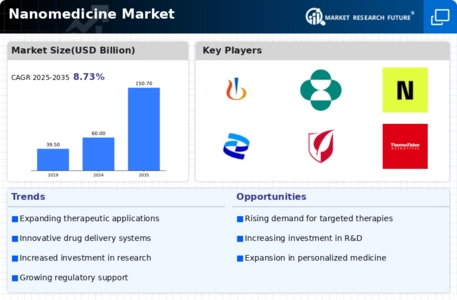Advancements in Nanotechnology
Technological advancements in nanotechnology are significantly influencing the Nanomedicine Market. Innovations in nanomaterials and their applications in drug formulation and delivery systems are enhancing the effectiveness of therapies. For instance, the development of nanoparticles that can encapsulate drugs and release them at targeted sites is revolutionizing treatment protocols. The market for nanotechnology in medicine is projected to grow substantially, with estimates suggesting a compound annual growth rate of over 10% in the coming years. This growth is driven by the increasing recognition of the potential of nanotechnology to improve drug solubility, bioavailability, and therapeutic efficacy. As research continues to unveil new applications, the Nanomedicine Market is likely to experience a surge in product offerings and investment opportunities.
Rising Prevalence of Chronic Diseases
The increasing incidence of chronic diseases such as cancer, diabetes, and cardiovascular disorders is a primary driver of the Nanomedicine Market. As these conditions become more prevalent, there is a growing demand for advanced therapeutic solutions that can enhance treatment efficacy and minimize side effects. Nanomedicine Market offers innovative approaches, such as targeted drug delivery systems, which can significantly improve patient outcomes. According to recent estimates, the global burden of chronic diseases is expected to rise, necessitating the development of novel treatment modalities. This trend is likely to propel investments in nanomedicine research and development, thereby expanding the market. The Nanomedicine Market is poised to benefit from this shift, as healthcare providers seek more effective and personalized treatment options for their patients.
Increasing Demand for Targeted Therapies
The demand for targeted therapies is on the rise, significantly impacting the Nanomedicine Market. Patients and healthcare providers are increasingly seeking treatment options that minimize side effects while maximizing therapeutic efficacy. Nanomedicine Market offers the ability to deliver drugs directly to diseased cells, thereby reducing the impact on healthy tissues. This targeted approach is particularly appealing in oncology, where traditional therapies often result in severe adverse effects. Market analysis indicates that the targeted drug delivery segment within nanomedicine is expected to grow at a rapid pace, driven by advancements in formulation technologies. As the healthcare landscape evolves, the Nanomedicine Market is likely to adapt to these changing preferences, leading to the development of more sophisticated and effective treatment modalities.
Growing Investment in Research and Development
Investment in research and development (R&D) within the Nanomedicine Market is witnessing a notable increase. Governments and private entities are allocating substantial funds to explore the potential of nanomedicine in various therapeutic areas. This influx of capital is fostering innovation and accelerating the development of new nanomedicine products. For example, funding for nanomedicine research has seen a rise of approximately 15% annually, reflecting the growing recognition of its importance in modern healthcare. This trend is expected to continue, as stakeholders aim to harness the benefits of nanotechnology to address unmet medical needs. The enhanced focus on R&D is likely to lead to breakthroughs that will further solidify the position of the Nanomedicine Market in the healthcare landscape.
Regulatory Support for Nanomedicine Innovations
Regulatory bodies are increasingly recognizing the potential of nanomedicine, providing a supportive framework for its development and commercialization. This regulatory support is crucial for the Nanomedicine Market, as it facilitates the approval process for new products and encourages innovation. Recent initiatives aimed at streamlining the regulatory pathways for nanomedicine products have emerged, which could expedite the time to market for novel therapies. As regulations evolve to accommodate the unique characteristics of nanomedicine, companies are likely to invest more in this field, anticipating a favorable environment for product development. The alignment of regulatory frameworks with scientific advancements is expected to bolster the growth of the Nanomedicine Market, fostering a climate of innovation and collaboration.

















